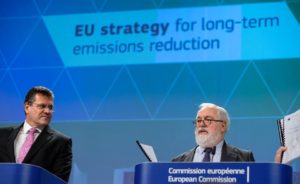Kategori : ENERGY AGENDA NEWS, ENERGY EFFICIENCY NEWS - Tarih : 06 January 2019
The European Union today unveiled a strategy to get its contribution to global climate change down to zero in just 30 years. The EU would be the first major economy to reach such a milestone.However, the proposal faces several hurdles as it makes its way toward a vote by the EU’s parliament and national governments, and critics have accused the European Commission, the EU’s executive branch which devised the proposal, of pulling its punches to placate lower-ambition European countries.
The strategy, which was put forward one week before the United Nations begins this year’s global climate summit in Poland, outlines eight possible scenarios for the EU to move toward its pledges under the Paris climate agreement. The rules for the agreement are going to be devised at next week’s summit.
 The timing of the proposal is meant to spur other global actors such as China to ratchet up their commitments in the agreement. It is also meant to show firm European commitment to the deal as it faces challenges from U.S. President Donald Trump and Brazil’s new president Jair Bolsonaro.
The timing of the proposal is meant to spur other global actors such as China to ratchet up their commitments in the agreement. It is also meant to show firm European commitment to the deal as it faces challenges from U.S. President Donald Trump and Brazil’s new president Jair Bolsonaro.
Trump has announced his intention to pull the U.S. out of the Paris Agreement, and Bolsonaro pledged during his campaign in September to follow the U.S. out. He walked back that pledge in the week before last month’s election. But yesterday Brazil announced it is rescinding its offer to host next year’s U.N. climate summit.
Earlier this week Trump dismissed as false a report from his own government warning of dire economic consequences if the U.S. does not act to stop climate change, and doubled down on his insistence that the U.S. will not set emissions reduction targets. He said he remains a nonbeliever in climate change, citing his “high level of intelligence” as the reason.
Not quite zero
The proposal does not outline any scenario in which the EU stops producing greenhouse gas emissions entirely. Instead, it’s most ambitious scenario lowers emissions to “net-zero” – a low level where the residual amount is counteracted through emissions-abatement practices elsewhere, such as the use of carbon capture and storage technology or the planting of forests to act as carbon sinks.
However the strategy has come into criticism for presenting the “net-zero emissions by 2050” option as the most ambitious scenario. Other possibilities include an 85% decrease in emissions, or a net-zero goal to be reached in later decades.
Originally, the Commission had signalled that it would put forward the net-zero goal as the only goal. However, following pressure from heavy industry and some national governments including Poland and Germany, the net-zero goal was instead made to be just one of several options envisaged.
Observers have noted that in such strategy documents, the most ambitious option is almost never chosen by the 28 EU national governments. They usually choose the middle option. And they have the final say.
At the same time, the net zero by 2050 option may stand a chance. National governments representing half the EU’s population have come out in favor of the idea. But more support would be needed for it to be approved.
Bas Eickhout, the European Green Party’s candidate to become the next president of the European Commission, called the strategy “an underwhelming and unambitious document.”
“The European Commission is kicking the can down the road by postponing implementation until 2030 and avoiding difficult conversations with certain member states out of political convenience,” he said.
Others have criticized the strategy for not proposing to change the EU’s existing goal for 2030 of reducing emissions by 40%.
However, EU climate commissioner Miguel Arias Cañete insisted that the strategy will demonstrate the EU’s seriousness when its representatives go to Poland next week. He said the Commission has a preference for the net zero by 2050 option, saying that it would spur €300 billion in new investment per year and boost the economy by up to 2% of GDP in 30 years.
“Climate neutrality by 2050 is of course the preferred option,” he said at a press conference today. “It’s feasible and it’s necessary. We have all the tools to be ambitious.”
“In the months ahead, these scenarios must be studied in detail, so that we achieve net-zero emissions by 2050 in the most cost-effective way.” Only two of the scenarios outlined would lead to this goal.
Dave Keating is a reporter in Brussels who has been covering EU politics and policy for 12 years.






